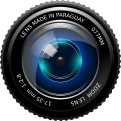Understanding the Fundamentals of Nature Photography
Before you begin capturing images of the great outdoors, it's important to understand the fundamentals of nature photography. This includes learning about the basics of composition, lighting & exposure.
Composition is a crucial element in nature photography. It involves arranging the elements within the frame to create a visually appealing image. When composing your shots, consider the rule of thirds, leading lines & other techniques to help you create a dynamic & interesting image.
Lighting is another important factor in nature photography. The quality and direction of light can greatly impact the mood & tone of an image. To capture the best lighting, it's important to understand the golden hour and how it can be used to your advantage. During the golden hour, the light is warm & soft, creating a beautiful & natural looking image.
Exposure is the amount of light that is allowed to reach the camera sensor. Understanding how to control exposure is essential for capturing high-quality images in a variety of lighting conditions. To control exposure, you'll need to understand the relationship between aperture, shutter speed & ISO.
Choosing the Right Equipment for Nature Photography
When it comes to nature photography having the right equipment is essential. A good camera and lens are the foundation of a great nature photography setup. When choosing a camera, look for one that offers a high resolution and the ability to control exposure settings. A good lens should have a fast aperture, image stabilisation, & a focal length that is suitable for the type of photography you are interested in.
In addition to a camera & lens, there are several other pieces of equipment that can be helpful for nature photography. A tripod is a must-have tool for capturing sharp images in low light conditions. A polarising filter can help to reduce glare & improve the saturation of your images. And a camera backpack can make it easier to transport your equipment when you're out in the field.
Tips and Tricks for Capturing Stunning Nature Images
Here are a few tips & tricks to help you capture stunning nature images:
Get close to your subject: Don't be afraid to get up close and personal with your subject. By getting close you can capture more detail and create a stronger connection between the viewer and the subject.
Pay attention to the background: The background of an image is just as important as the subject itself. Make sure the background is visually appealing & does not distract from the subject.
Use the right time of day: The golden hour is the best time to capture images of nature. However there are other times of day that can be just as effective, such as sunrise, sunset & the blue hour. Experiment with different times of day to see what works best for you.
Experiment with different angles: Try shooting from different angles to add interest to your images. Shoot from a low angle to give a sense of height, or from a high angle to give a sense of depth.
Be patient: Nature photography often requires a great deal of patience. Wait for the right moment to capture the perfect shot.
Conclusion
Nature photography is an art form that requires a combination of technical skills, creativity & patience. Whether you are an amateur or professional photographer, capturing the beauty of the outdoors can be both challenging & rewarding. With the right tools, techniques & approach, you can create stunning images that truly showcase the natural world around us.
By following the tips outlined in this article, you can improve your nature photography skills & capture images that will take your breath away. Whether you prefer to photograph landscapes, wildlife, or close-up shots of flora and fauna, there is no limit to what you can achieve.
So grab your camera, head outdoors & start exploring the art of nature photography. Who knows, you may just find a new passion that will inspire you for years to come.
High-End Gear for Nature Photography
When it comes to nature photography having the right equipment can make all the difference. Whether you are looking to capture stunning landscapes or elusive wildlife, having the right gear can help you achieve your vision. In the next three points we will provide examples of high-end gear that can help you take your nature photography to the next level.
1. Canon EOS 1DX Mark III
The Canon EOS 1DX Mark III is a professional-level digital SLR camera that offers a range of advanced features and functions. With a 20.1 megapixel full-frame sensor this camera is capable of capturing high-resolution images with incredible detail and clarity. It also features dual DIGIC X processors, which allow for fast & responsive performance making it ideal for capturing fast-moving wildlife.
Pros:
- High-resolution images with incredible detail & clarity
- Dual DIGIC X processors for fast and responsive performance
- Advanced autofocus system with 191 AF points
Cons:
- Price: This is a high-end camera & can be expensive for some photographers.
- Weight: The camera is on the heavier side, which can be a challenge for outdoor photography & long hikes.
2. Sony Alpha a9 II
The Sony Alpha a9 II is a full-frame mirrorless camera that offers advanced features & functionality for nature photographers. With a 24.2 megapixel sensor, fast autofocus system & advanced image stabilisation, this camera is designed for high-quality results in a compact and portable form factor. It also features a high-speed continuous shooting mode which allows you to capture fast-moving action with ease.
Pros:
- Compact and portable form factor
- High-speed continuous shooting mode
- Advanced image stabilisation for stable and sharp images
Cons:
- Limited lens options compared to other full-frame cameras
- Battery life: The battery life is not as long as some other cameras, which can be a challenge for outdoor photography.
3. Nikon D6
The Nikon D6 is a professional-level digital SLR camera that is designed for serious nature photographers. With a 20.8 megapixel full-frame sensor & advanced autofocus system, this camera is capable of capturing high-quality images with incredible detail & clarity. It also features built-in Wi-Fi and GPS making it easy to share your images and track your photography locations.
Pros:
- High-quality images with incredible detail and clarity
- Advanced autofocus system for sharp and accurate focus
- Built-in Wi-Fi and GPS for easy image sharing and location tracking
Cons:
- Price: This is a high-end camera and can be expensive for some photographers.
- Weight: The camera is on the heavier side, which can be a challenge for outdoor photography & long hikes.

